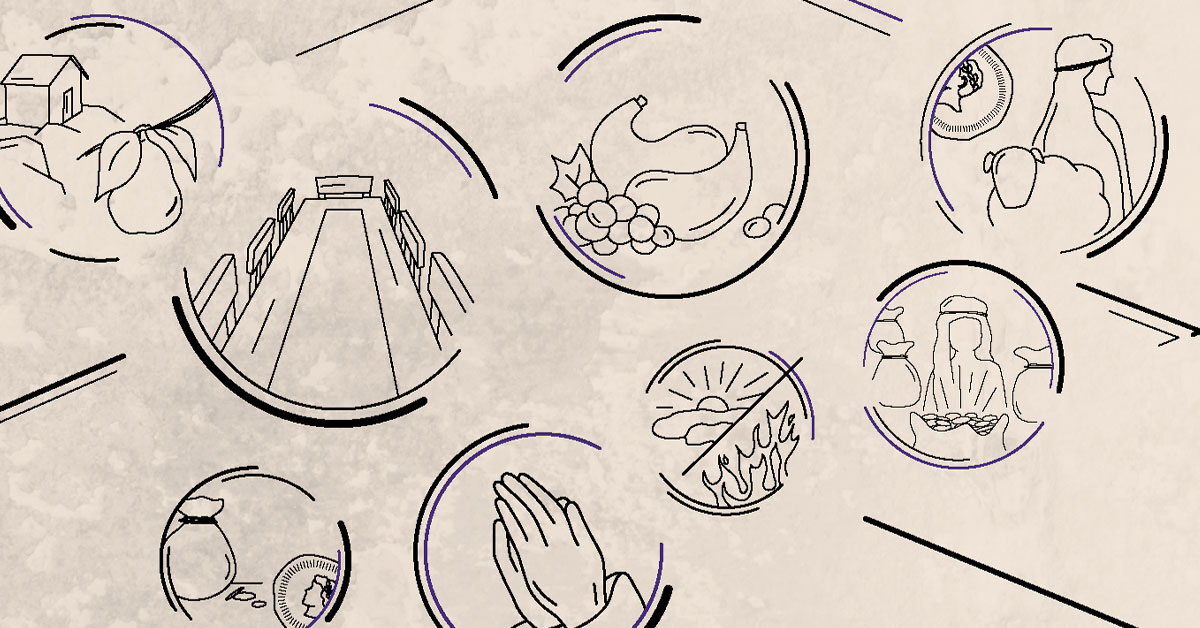Lenten Experience Guide
Lenten Experience Guide
What exactly is Lent? And why do we practice it?
Different religious traditions observe Lent in different ways. But essentially, Lent is a 40-day observance leading to Holy Week and Easter. The 40 days correspond to Jesus’ time fasting in the wilderness prior to the beginning of His earthly ministry.
The purpose of participating and engaging in this time of preparation is to come closer to Jesus. As Christians, we can also use Lent to prepare and anticipate what God is going to do in our lives. Lent is not just a season of giving something up, but it is really a season of focus – focusing our attention and being intentional about the work of God in our lives. Lent is a time to press in to some intentional practices and listen for where God is leading and what He is doing in your heart.
As we enter into this season of Lent at Pulpit Rock, we want to focus our hearts on a tool Jesus gave us in order to change us.
One of the most profound tools Jesus used to lead people was parables.
He would tell these little stories that were rich in imagery. And then He would stop talking. Imagine if you and I were sitting in the crowd... so many of His stories would provoke deep thinking. They would spark questions in our heart. They would force us to consider things in new ways. His parables were like on-ramps to true spirituality.
So this season, we want to take time to reflect deeply on 12 parables found in the Gospel of Luke, and let them sit in our hearts so they can shape us.
Some of them are very challenging. Some of them are very comforting. Some of them will stick with us for the rest of our lives. And all of them will shape us.
- Jonathan Cleveland, Senior Pastor
Parables are often thought to be simple or short stories with a moral or spiritual lesson. The parables of Jesus are so much more than this.
N.T. Wright said, “Jesus’ stories are designed to tease, to clothe the shocking and revolutionary message about God’s Kingdom in garb that would leave the listeners wondering, trying to think it out. Whatever the parables are, they are not, as children are sometimes taught in Sunday school, ‘earthly stories with heavenly meaning.’ Rather, they are expressions of Jesus’ shocking announcement that God’s Kingdom was arriving on earth as in heaven.”
Parables are an invitation to question, to think, and ultimately to be moved to action. Parables don’t usually try to teach us something new, but rather to see something we’ve overlooked, or perhaps challenge us to see things in a different way.
This guide is intended as a resource to help you engage with the Lord over the next 40 days. Each week we’ll be using one of Jesus’ parables from Luke as a jumping-off point.
This page provides and explains several different options for engaging with the parables. Some of these activities may be familiar to you, and some may stretch and challenge your spiritual growth this season.
Each practice can be used intentionally to bring you into the presence of God. You can use a different practice each day, a couple throughout the week, or just one. Whatever you choose, we hope that you will stretch yourself in this season to walk alongside Jesus as He tells us these stories, allowing them to show us Himself and His Kingdom more fully.
You can pick up a Lenten Experience Guide on Sunday mornings, or print your own.
If you would rather engage digitally, you're in the right place!
The Parables
Each of the sections below corresponds with the parables we'll cover each Sunday. Simply click on the passage of Scripture listed under each date, and it'll take you straight to the parable - where you'll be able to read multiple translations, listen to it, and find other helpful tools!
The Practices
There are several different options for engaging with the parables.
Each practice can be used intentionally to bring you into the presence of God. You can use a different practice each day, a couple throughout the week, or just one.
This is not studying the Bible for knowledge, but for intimacy with God. It’s a mix of reading and praying – sitting in His presence with a reflective heart and no expectations other than dedicated time hearing what He wants to whisper to your soul.
Here is one of several ways to read in Lectio Divina; you’ll read the passage four times, and you can take some time in silence and/or prayer in between each reading...
Read | Read slowly and allow the story Jesus is telling to come alive. Be open to hearing from the Holy Spirit.
Meditate | Focus on a part of the passage you are drawn to, repeat it to yourself a couple of times, turning it over and over in your mind. What word or phrase is impressed on you?
Pray | Spend time praying from what the Scripture and the Holy Spirit has surfaced in you. What are you feeling? What might you need to confess? What do you want to ask for yourself or others?
Contemplate | Rest quietly in the words of Jesus. Take as much time in His presence as you are able. Let the words of Scripture move from your mind to your heart.
For many, participating in Lent means fasting from something. Fasting means to give up something that is enjoyable, not as a punishment, but instead to pay more attention to God and make space to hear from Him.
A way to ‘empty us so that the Lord may fill us.’ - Thomas McKenzie
You may also choose to fast from harmful or negative things to intentionally make room for His good. Fasting from things that bring comfort, things that are unnecessary or things that are distracting and numbing can be a great way to remind us, many times a day, to go to God for His comfort and allow Him to have space to work.
Listening prayer slows us down. It is a shift from much of the praying we often do – talking and asking. Getting truly quiet and open enough to listen can be a challenge, but these quiet and still moments with God soften our hearts. As we just sit in His presence, we begin to notice and hear things we otherwise would miss.
Quiet | Take a few deep breaths, clear your mind of distraction. This will be hard at first, but every time your mind wanders, gently refocus. It will get easier the more you practice.
Listen | Ask Him to be with you. Tell Him that you intend to listen for anything He may want to say. Then do just that, sit quietly and listen. Start with just a couple of minutes and work your way up to longer periods of time as you get better at just being with Him.
Reflect | Take note of anything you feel that God impressed upon you during your listening. Maybe it was a Scripture or a song or a challenge to act. Are the things you hear Him saying consistent with His word?
This practice can also be done in a group setting or in conjunction with reading a passage from the Bible. Sit in the quiet and listen individually, then you can read and reflect together.
Visio Divina (or divine seeing) is the practice of prayerfully inviting God to speak to your heart as you look at an image. Creativity is a gift from God, and we can use works of art to encounter Him. It can be done by yourself or with others, and is great to do with kids!
Find an image | You can use an image or real piece of any kind of art. Find some parable specific images on our Pulpit Rock Visio Divina Pinterest board. Ask the Lord to speak to you.
Focus small | Look at the image and let your eyes stay with the first thing you notice. Keep your focus on that small part for about a minute or so.
Focus on the whole | Now look at the entire image. Take your time and look at every part.
Reflect | How do you feel looking at the image? What does the image stir up in you? If you had to describe the image in a sentence or two what would you say? If you were in the image, where would you place yourself? Do you get a glimpse of the sacred from this image? What might God be saying to you through this image?
Pray | Finish with a prayer. If desired, keep the image in a place you can see it throughout the day. You can journal or practice your own creativity with the image and what He shows you as inspiration.
Often when we read the Bible, it is by ourselves, and it is silent. But the stories Jesus told were spoken aloud – they were told to at least one other person.
Eugene Peterson said, “It is important to keep that original oral quality in mind, that living voice of Jesus, the spoken words that came from His mouth and entered the lives of men and women through listening ears and believing hearts.”
Experiencing the words of Jesus in the fashion that He spoke them and discussing with others can show us things we haven’t seen before. This type of reading is formative, shaping the way you think about things, and shaping your community!
Read aloud | Take the parable and read it out loud to at least one other person. Or listen to it read from a Bible app. Maybe read it in a few different versions. You can do this one parable at a time or read a large section of Luke all together.
Respond | Talk about what you read together. Talk about who Jesus was telling the story to. How does it fit within the entire gospel of Luke? Where does this parable overlap with things Jesus taught elsewhere?
Additional Resources
- Check out our Visio Divina board on Pinterest!
- Find some great songs to listen to this season on our Spotify playlist.
- Check out this playlist for kids with songs about the parables!
- Bible Project Parable Series
- Preparing for Easter | Don't Mom Alone
- Daily Lectio Divina
- Bread and Wine: Readings for Lent and Easter
- Tell it Slant by Eugene Peterson
- The Power of Parable by John Dominic Crossan
- Short Stories by Jesus by Amy-Jill Levine
- Lent for Everyone by N.T. Wright on the YouVersion Bible App
On the Blog...
Should I Fast During Lent?
A few thoughts and ideas to help you in your decision making about fasting during Lent.
Why Parables?
Why are we focusing on the parables of Jesus during this season of Lent?
How Do I Engage With My Kids During Lent?
10 ways to engage with your kids during the season of Lent!
- « Previous
- 1
- 2



